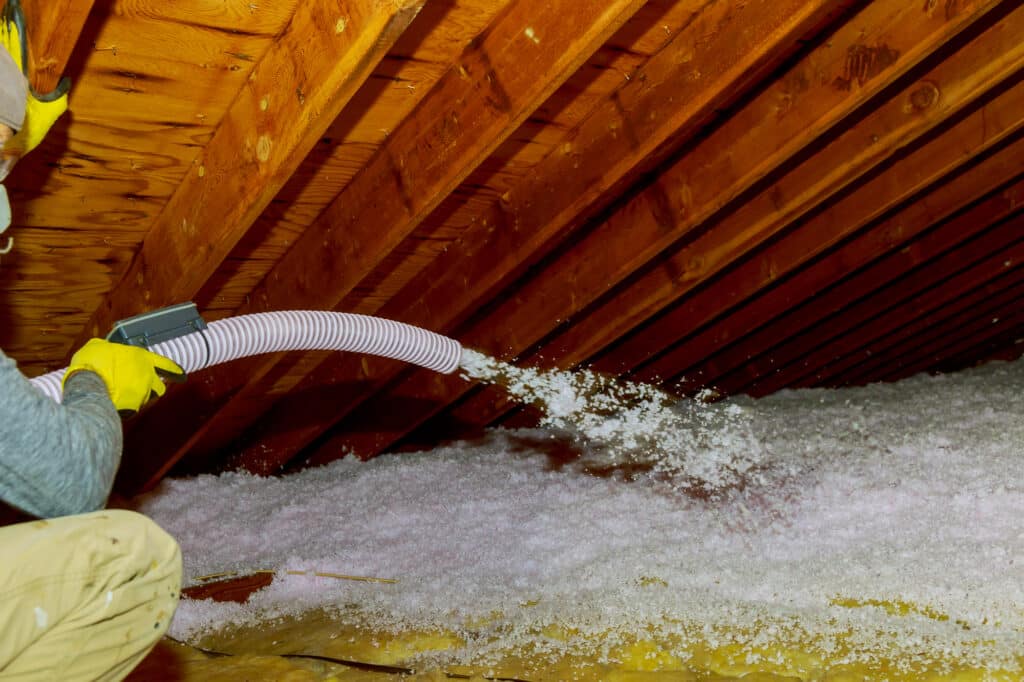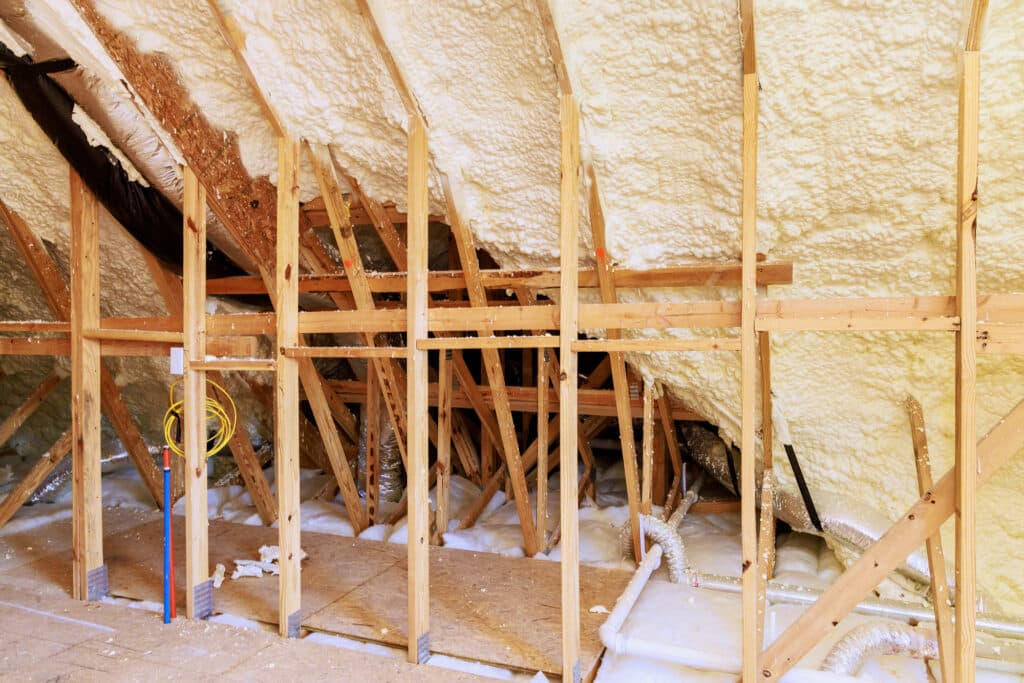Attic insulation is crucial in maintaining energy efficiency and comfort in homes, especially in regions like Dallas-Fort Worth (DFW), where extreme temperatures are expected. Adding radiant barrier insulation can provide an extra layer of protection against heat. Homeowners must understand the basics of insulation, its benefits, including radiant barrier and wall insulation, and the common issues that arise with inadequate insulation.
What is Attic Insulation, and Why is it Important?
Understanding the Basics of Insulation
Insulation is a barrier that helps regulate heat flow in and out of a home, mainly when materials like cellulose and fiberglass insulation are used. Radiant barrier insulation can enhance this effect by reflecting heat away from the house. Proper insulation in the attic is vital for preventing heat loss during winter and heat gain in the summer, creating a more comfortable indoor environment. This includes the application of attic ventilation services and superior attic insulation techniques.
Benefits of Proper Attic Insulation
Proper attic insulation not only enhances energy efficiency but also helps in reducing utility bills by effectively insulating the home. It provides a consistent temperature throughout the house, making it more comfortable for occupants. Additionally, it can extend the lifespan of heating and cooling systems.
Common Issues with Inadequate Insulation
Inadequate attic insulation can lead to energy wastage, uncomfortable living conditions, and potential damage to the home’s structure due to moisture retention. Attic insulation removal and replacement with superior insulation options can mitigate these issues. It can also result in uneven temperature distribution and increased strain on HVAC systems, problems that superior attic insulation and professional attic ventilation services can address. A free energy audit can help you find opportunities to maximize your savings and energy efficiency.
Types of Attic Insulation to Consider
Comparing Batt, Blown-In, and Spray Foam Insulation
Fundamentally, selecting the right attic insulation for your home involves weighing the benefits of each material alongside your specific needs—such as energy efficiency goals, budget, and home architecture. In the Dallas-Fort Worth area, where temperatures can soar in summer and drop significantly in winter, the right insulation choice is crucial for maintaining comfort and managing energy costs.
Homeowners can opt for batt insulation, blown-in insulation, cellulose insulation, wall insulation, or spray foam insulation. Batt insulation comes in pre-cut panels, blown-in insulation is loose-fill material blown into the attic space, and spray foam insulation expands to fill gaps and cracks for a tighter seal.
Batt Insulation

Batt insulation, commonly made from fiberglass or mineral wool, is a traditional choice for many homeowners. Its pre-cut, flexible panels are designed for easy installation between framing, such as studs and rafters. While batt insulation is highly effective for uniform spaces and offers a straightforward DIY option, it may not provide the most comprehensive coverage in attics with irregular nooks or widespread air leaks.
- Pros: Affordable, easy to install in standard spaces, and offers good thermal resistance.
- Cons: Can leave gaps if not properly installed, less effective in irregularly shaped areas.
Blown-In Insulation

Blown-in insulation, made of fiberglass, cellulose, or mineral wool, is precisely what it sounds like—small, loose-fill particles blown into the attic space. This method is particularly effective in covering nooks and crannies, offering a more complete insulation solution than batts in many cases. It’s especially beneficial in older DFW homes where there may be numerous gaps and uneven spacing between joists.
- Pros: Provides a comprehensive coverage, ideal for irregular and hard-to-reach spaces, and often has a higher R-value per inch for cellulose materials.
- Cons: Requires professional installation; cellulose is more eco-friendly and can settle over time and reduce effectiveness.
Spray Foam Insulation

Spray foam takes home insulation to the next level by providing an air-tight seal. It expands upon application, filling even the smallest gaps and cracks. This insulation type is split into two categories: open-cell and closed-cell spray foam, with the latter being denser and offering higher R-values as well as moisture barrier properties. In the fluctuating climate of DFW, spray foam insulation can significantly reduce energy bills by maintaining indoor temperature levels more effectively.
- Pros: Superior air sealing capabilities, excellent thermal resistance, and moisture barrier properties (closed-cell foam).
- Cons: Higher initial cost, requires expert installation for optimal safety and performance.
Factors to Consider When Choosing Insulation Type
When selecting the correct type of insulation for your attic, consider factors such as the R-value, installation cost, effectiveness in different climates, and whether cellulose or fiberglass insulation would be more effective. The R-value indicates the insulation’s thermal resistance, with higher values providing better insulation. Wall insulation often has a significant R-value, contributing to a home’s energy efficiency.
Exploring Different R-Values for Insulation
R-value per inch varies for different types of insulation materials. For example, spray foam insulation typically has a higher R-value than fiberglass batts, making it a more efficient choice for insulation with limited space and ensuring that you insulate effectively.
What are the most common insulation materials used in DFW homes?
The most common materials used to insulate the attic are loose-fill insulation and rolls of insulation. These materials are ideal for covering the attic area and providing a layer of insulation to keep your home warm in the winter and cool in the summer. Insulation blowers are often used to install insulation in unfinished attics, ensuring sufficient insulation meets your insulation needs. Insulating your attic with the best insulation available is essential to ensure your home can resist heat transfer.
When choosing the suitable insulation material for your home, it’s essential to consider factors such as insulation for your home’s wall cavities and a layer of insulation needed. While asbestos was commonly used, it is no longer considered a safe option for insulation in your attic. Instead, newer materials with better insulation properties are now available to insulate your attic effectively. It may be time to insulate your loft if you notice a lack of insulation or higher energy bills. Inspecting the attic regularly can help determine if you need to add new insulation to maintain a comfortable home environment.
Insulation Installation Process and Tips
DIY vs. Professional Installation
While some homeowners may choose to install attic insulation themselves to save on costs, professional installation ensures proper sealing and ventilation. The higher the R-value, the better the insulation efficacy. Hiring a certified contractor or installer can guarantee a well-insulated attic that meets energy efficiency standards, properly utilizing materials like cellulose or fiberglass insulation for maximum effectiveness.
Ensuring Proper Sealing and Ventilation
A well-insulated attic should be adequately sealed to prevent air leaks and ensure effective insulation. To ensure the highest quality of work, professional attic insulation removal or installer services often undertake this task. Adequate ventilation is necessary to maintain the attic’s temperature and moisture levels, contributing to the home’s overall energy efficiency. This can be achieved through comprehensive attic ventilation services.
Tips for Maximizing Energy Efficiency
To maximize energy efficiency, homeowners should consider adding insulation to the attic floor, crawl spaces, walls, and rafters. This comprehensive approach helps create a more energy-efficient home that is comfortable year-round.
Cost Considerations for Attic Insulation
Understanding the Cost Factors Involved
The cost of attic insulation may vary based on factors such as insulation type, R-value, whether cellulose or fiberglass insulation is chosen, and the size of the attic space. While initial costs may differ, investing in high-quality insulation, like a radiant barrier or wall insulation, can result in long-term energy savings and increased home value.
Comparing Costs of Different Insulation Types
When comparing costs of different insulation types, homeowners should look beyond the initial investment and consider the long-term benefits each type offers, primarily focusing on the higher the R-value, the better the energy efficiency. Factors like durability, maintenance, and energy savings should all be considered.
Budgeting for Attic Insulation Projects
A budget for attic insulation projects is essential to ensure the installation process stays within financial constraints. Homeowners can consult insulation companies for cost estimates and choose the best insulation option that fits their budget.
Additional Strategies for Energy-Efficient Attics
Utilizing Radiant Barriers in Attic Spaces
Radiant barriers and venting can be installed in attic spaces to reflect heat away from the home, reducing indoor temperatures and lowering cooling costs. Incorporating these barriers and proper insulation can significantly improve energy efficiency and help insulate the house more effectively.
Importance of Proper Ventilation and Insulation Combination
Proper ventilation and insulation, including attic ventilation services and radiant barrier insulation, are crucial for maintaining energy efficiency. Solar attic fans can help remove excess heat and moisture from the attic, reducing the load on the HVAC system and enhancing overall comfort while energizing the home’s ventilation system. This is especially effective when combined with superior attic insulation removal and attic ventilation services.
Choosing the Right Insulation for DFW Climate
Considering the climate in the Dallas-Fort Worth area, homeowners should choose insulation that is suited for hot summers and mild winters, such as radiant barrier or wall insulation. Factors like solar heat gain and humidity levels should be considered when selecting the proper attic insulation.
Frequently Asked Questions About Attic Insulation in DFW
What is the recommended insulation for an attic in Texas?
In Texas, where temperatures can vary significantly, the recommended insulation for an attic should have a high R-value to effectively keep the home cool in the hot summer months and warm during the cooler winter periods. While the specific type of insulation—such as batt, blown-in, or spray foam—can vary based on the particular needs of the home, experts often suggest insulation with an R-value of R-38 for attics in the Texas region.
What are the guidelines for attic insulation?
The guidelines for attic insulation revolve around achieving the appropriate R-value for the climate zone, ensuring that the insulation is properly installed to prevent air leaks, and considering moisture control. Insulation should be evenly distributed with no gaps, and factors such as ventilation and potential condensation should be addressed to prevent any long-term damage. It’s also important that insulation not block soffit vents and that it is kept away from recessed lighting fixtures unless they are rated for insulation contact.
What R rating is best for attic insulation?
The best R-rating for attic insulation depends on your climate zone. However, the U.S. Department of Energy generally recommends an R-value of R-30 to R-60 for attics in regions that experience mild to hot climates, like Texas. Homes in cooler climates might require an even higher R-value. It’s essential to check local building codes and Department of Energy recommendations for the most accurate guidelines for your area.
How do I figure out how much insulation I need in my attic?
To calculate how much insulation is needed for an attic, you’ll need to determine the attic’s square footage and the desired R-value. Afterward, check the R-value per inch of your chosen insulation material and calculate the thickness needed to achieve the target R-value. Insulation is often sold in rolls or bags covering a certain number of square feet at a specified thickness, so once you have your attic’s square footage and the necessary insulation thickness, you can purchase the requisite amount to adequately cover your attic space. Always remember to consider existing insulation when adding new layers, as the R-values will add up to a cumulative total.
